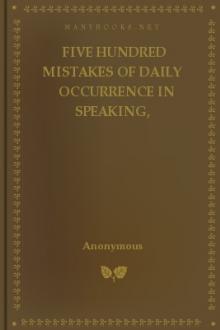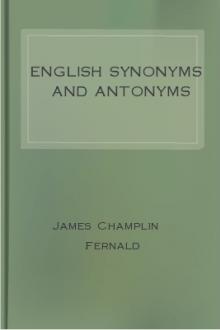How to Become Rich, William Windsor [readera ebook reader txt] 📗

- Author: William Windsor
- Performer: -
Book online «How to Become Rich, William Windsor [readera ebook reader txt] 📗». Author William Windsor
“The peculiar form of the Cliff Dweller’s skull is produced by some custom of the tribe in binding the infant upon a board or other substance. This is proved by the fact that the flatness of the back head is uniformly at the same angle, and that the upper tables of the skull give evidence of abnormal pressure. There is also in this collection one skull which is an exception, and shows exactly the development we would expect to find in a normal form when such pressure was not applied. The skull is that of a young female, and in outline it is strikingly like that of the ordinary Caucasian skull. In fact, I would pronounce it a Caucasian skull were it not for the structure of the superior maxillary bone, which shows a radical departure from the type of either of the five present races. The Cliff Dwellers are more like the Caucasian than the Indian, and more like the Hindoo than either. That they possessed a higher order of intellect than any Indian tribe of which we have knowledge does not admit of doubt.
“The most striking peculiarity of these skulls is their delicate and yet strong quality. The grain or texture of the bone is much more delicate and fine than the average of Caucasian skulls that belong to the uneducated classes. The illumination of the skull discloses some interesting facts. It is well known to phrenologists that the skull is thinner in those regions that are most constantly used in the mental habits of the individual. The illumination of the skulls of these two youths (here Professor Windsor inserted a lighted taper in each) discloses a nearly uniform thinness of the entire skull, showing that they exercised all the faculties of the mind. The skull of this old warrior, however, presents a different appearance under the same test. You will notice that the illumination is confined to that portion of the skull lying around the base of the brain, and running highest in the forehead. The conclusion to be drawn from this is that the individual who once wore this skull was a man of very practical intellect. The perceptive organs, the knowing and reasoning faculties, executive ability and the social organs of amativeness and friendship, particularly the latter, are all bright and particularly well developed.
“The abnormal width of the Cliff Dweller’s skull through the middle section, and the massive, dome-like forehead, is due in a measure to the crowding forward of the brain from the pressure which produced the flattening of the occiput. Any normal head with such a development would show a thinness of the bone in that region, whereas the opacity of the warrior’s skull is remarkable in that region. If we may take the skull of this female, which has not been subjected to this pressure, as a type of the race, we are justified in considering the Cliff Dwellers as a people remarkably agreeable in traits of character. All the domestic propensities which form the basis of the family relation, the love of offspring, of friends and neighbors, are remarkably well developed. There is a magnificent moral influence shown in the development of conscientiousness, approbativeness and caution. The latter organ is so large as to suggest cowardice, but these people undoubtedly lived in an age when circumspection and eternal vigilance was the price of existence as well as of liberty.
“I notice that the writer of the article on the Cliff Dwellers in last Sunday’s Republican makes the statement that they apparently had neither literature nor religion. He bases his assertions on the fact that he does not find altars or writings among their possessions. But appearances are against him. They apparently had both, from the structure of their skulls. The Cliff Dweller is largely endowed with the artistic and constructive organs of the brain with an unlimited capacity for invention and designing. Savage races far below him in these qualities have literature, and it is unreasonable to suppose that having these qualities both large and active, he did not use them. As to his religion, the single exception to the uniform opacity of the warrior’s skull above mentioned in the crown of the head is in the organ of veneration. He did not have enough of spirituality and faith to supply a Methodist camp meeting, but he undoubtedly reverenced the Great Spirit and invoked the patronage of the god which he could comprehend. The other two skulls show as good a development of the religious organs as you will find in a general average of any Sunday-school in Denver. The Cliff Dwellers were undoubtedly religious.
“In physical structure the Cliff Dweller presents a greater variety than is found in any race except the Caucasian. Their warriors were undoubtedly men of great endurance and strong physique with a good size of body. There were also among them types of character delicate in the extreme and possessing but little endurance. As a race they depended on prudence rather than strength for safety. They were shrewd, circumspect and diplomatic. In complexion they were darker than the Caucasian and much lighter than the American Indian. In diet they were almost if not quite exclusively graminivorous, living on grain and eating that raw.”
“How do you tell that? Professor,” asked the scribe. “Isn’t that getting things down very fine for so long a lapse of time?”
“Oh, no; just look at the teeth of all these skulls and you will see that they are worn—even these young skulls which have not developed the wisdom teeth have the molars half worn away. The canine teeth are almost rudimentary in these skulls—in the carnivorous races of men they are very large. The condition of these teeth could only be produced by such a diet. If the Cliff Dweller had subsisted to any extent on meat or had eaten his grain cooked, he would not have worn the teeth one-quarter as much at the age of these younger skulls. Moreover, he did not use tobacco, which also leaves its mark on the skull, in the deterioration of certain organs of the brain, which, to the credit of the Cliff Dwellers, are well developed.
“If it is true that—
The good is oft interred with their bones—’
it is equally true, that by resurrecting the bones we may read the history of both the evil and the good.”
*Note.—The “Cliff Dwellers” is a name given to an ancient aboriginal race who once inhabited the mountain fastnesses of the Rocky Mountains in Colorado. They had their homes in caverns of almost inaccessible cliffs, and undoubtedly possessed an advanced state of civilization, as evidenced from the pottery, implements, musical instruments, etc., found in the ruins of their homes, as well as what is indicated by the skulls described in this interview. Their dwellings exhibit remarkable constructiveness in the inmates, and in many instances a high power of decorative art.
[Return to text.]
A PHRENOLOGICAL STUDY.Henry W. Grady’s Character Analyzed by an Expert. What a Study of the Mask and of Photograph Shows—His Wonderful Brain and its Wonderful Capacity.
Atlanta Constitution.
“Yes, I have given the character of Henry W. Grady considerable study, as I do in the case of all men who attract public attention by their graces, gifts and accomplishments, or by the lack of those attributes.”
The speaker was Professor William Windsor, LL. B., phrenologist and anthropologist, whose lectures last week at the Guard’s armory interested the people of Atlanta in the study of human character.
“Mr. Grady has interested me ever since I first heard of him, and I had looked forward to meeting him personally here in Atlanta this winter, ever since my route was mapped out for the season. I feel a sense of personal bereavement in his death, for his characteristics were as vividly impressed upon my mind by the study I had made of the man as others experience from personal contact.”
“Perhaps you can tell us something of the character of Mr. Grady as viewed from the standpoint of your science that will be interesting, Professor,” suggested a representative of The Constitution, and the party of interested gentlemen drew more closely around the philosopher.
“Yes, indeed,” answered Professor Windsor, “but to me the contemplation of the character of Mr. Grady, at this time, is too much like viewing the wreck of a grand ship which was freighted with a precious cargo, and trying to estimate the loss. There isn’t much comfort in it, except in the fact that a correct estimate of the virtues and accomplishments of such a man, at a time when the community is still shocked at the calamity of his demise, is a powerful incentive to emulation on the part of other and younger men.
“From the phrenological standpoint Mr. Grady’s characteristics present an interesting study, while his known accomplishments are a wonderful confirmation of the correctness of the theory upon which we estimate mental power, namely, that size of brain is the measure of power, when temperament, quality and health of body are sufficient to support the brain. Comprehensive greatness is never manifested by a small brain. I have been placed in possession of very accurate measurements of Mr. Grady’s head through the courtesy of Mr. Frazee, the Atlanta sculptor who has a cast of the face and forehead made from the body of Mr. Grady, and hence strictly correct in dimensions. I have also had the benefit of numerous photographs, in which the phrenological features are distinctly preserved.
“Mr. Grady possessed a strong endowment of the magnetic temperament which gives a strong circulation of blood and a great activity of mentality. His height and weight show him to have had sufficient vitality to sustain his brain, and there was just enough of the electric temperament in him to darken his eyes and hair and give him intensity of feeling and action. His quality was exceedingly responsive and delicate, and these attributes are necessary to the class of orators to which he belonged.
“The size of his brain compares favorably with what is known of other intellectual giants, as the following measurements will demonstrate. The actual circumference of the head around the base of the brain was twenty-four inches. The measurement from ear to ear over the top of the head fifteen and a half inches, while the forehead measures from ear to ear over the perceptives twelve and a half inches, and from the same points over the region of sympathy fourteen inches. The massing of the intellect, it will be seen, was in the upper portion of the forehead; and that region shows a remarkable development of benevolence, suavity, causality, comparison and imitation.
“The most remarkable development, however, is in the organ of constructiveness, which gives a lateral expansion to the forehead which is almost enormous. This faculty is necessary to the correlation of thoughts and ideas, the construction of sentences and the formation of schemes and plans. As an inventor, Mr. Grady was superb, and his large sympathy would naturally lead him to the invention of social plans and philanthropic enterprises rather than machinery.
“His large language is indicated by the fullness under the eye. The phrenological organ of language lies above and behind the eye, and when large presses the eyeball forward and downward causing a fullness or sack under the eye which is very prominent in Mr. Grady’s portraits. In the power and scope of this feature he had more development than either Webster or Ingersoll.
“His large suavity enabled him to use his language in a way that pleased even his antagonists. Mr. Grady was emphatically combative, as shown by full development





Comments (0)